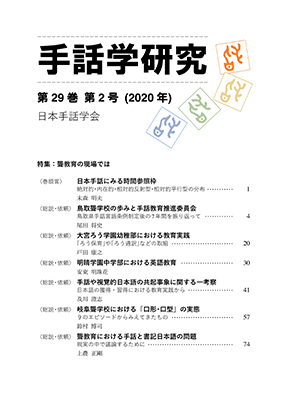The means of communication used by deaf children and adults are hearing aids, oral communication, sign language, fingerspelling, and skywriting, each of which is used dynamically according to the circumstances of the deaf child or adult. At the time of the current epidemic, the Gifu School for the Deaf took steps to distribute online learning supports, support from Gifu Prefecture and other organizations, and donations of free masks and transparent masks that show lips, tongue, and facial expressions. New vocabulary such as "cluster" and "lockdown" were introduced, and the new sign language was created by the Japan Institute for Sign Language Studies, but when I tried to read the sign language while wearing a mask, I could not understand it. I can read some of it using fingerspelling, but it is much easier to take off the mask and read it by the way the lips look along with the sign language. Therefore, I turned my attention to "oral communication" as one of the various means of communication. However, the term "oral communication" used here is not from the standpoint of vocalization and speech instruction, but refers to the shape of the lips and tongue as seen by the eyes of the deaf person, and includes the Japanese "Mouth Shape" and the sign language "Mouth Form". Since the proportions of "Mouth Shape" and "Mouth Form" vary from one deaf person to the next, the term "Mouth Shape and Mouth Form" was chosen to encompass these two as new. As an employee of the only school for the deaf in Gifu Prefecture, I observed the actual situation of Mouth Shapes and Mouth Forms in the field, and I wondered why the Japanese "Mouth Shape" was used so often. Also, in what situations is the "Mouth Form" of sign language, which the author (I, a deaf teacher) sometimes uses when he wants to express himself in a rich manner, used, and what impact has it had on the deaf children? While in school, deaf children acquire the Japanese language through the "Mouth Shape" and learn how to use it while acquiring public senses. Then, when they graduate and become members of society, they are influenced by the Japanese Sign Language and Identity of the fellow deaf people they meet in various places, and a unique "Mouth Form" used along with the Sign Language is seen, and there is a tendency to shift to a bicultural bilingual way of life of Japanese Language and Japanese Sign Language. In this paper, I would like to summarize and discuss the actual situation of deaf children at Gifu School for the Deaf using "Mouth Shape and Mouth Form" as a starting point.
View full abstract
